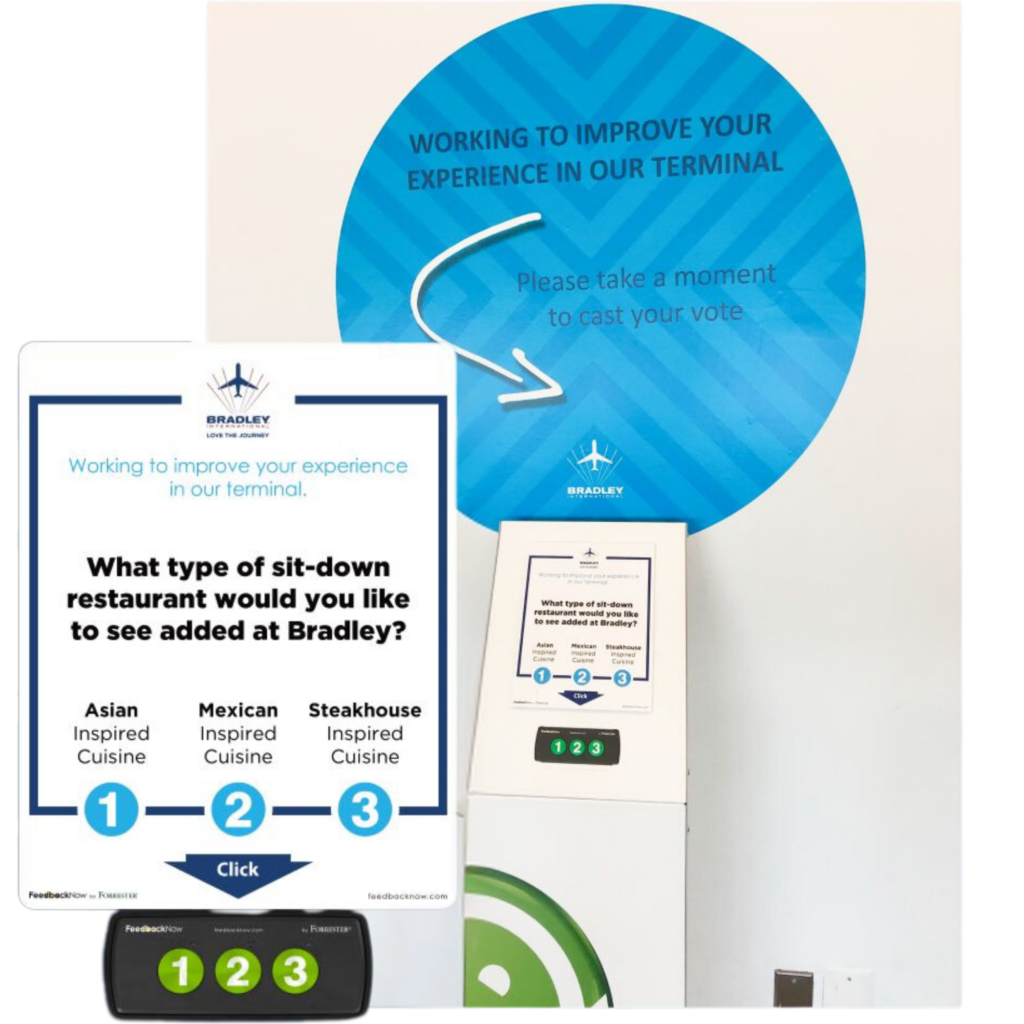
The recent Amadeus Travel Technology Investment Trends study (read about it here!) reveals insights into where airports are focusing their technology investments in 2024 and beyond. With an expected 17% increase in tech spending, it’s clear that airports recognize the critical role that innovative solutions will play in improving operations and enhancing the passenger experience.
While the study highlights several important areas of focus, from biometrics to cloud computing, there’s one investment that has the potential to be truly transformative: implementing a robust real-time operations and data collection system across your entire airport to capture important signals you are currently missing.
Enter FeedbackNow: Born out of a need for quick and actionable feedback to replace long surveys in airports, FeedbackNow has grown into an all-in-one solution to manage airport operations in real time. We turn the flood of confusing data into clear, useful directions that allow decision-makers to see the full scope of what’s happening, spot key trends, and focus their efforts where they’ll have the most impact.
The Power of Real-Time Insights
Imagine having a comprehensive, up-to-the-minute view of every aspect of your airport’s operations, from security wait times to baggage handling efficiency, retail foot traffic to aircraft turnaround times. This level of insight, made possible through strategically placed sensors and integrated data systems, can revolutionize how airports operate and serve their passengers.
- Proactive Problem-Solving: With real-time data at their fingertips, airport operations teams can identify and address issues before they escalate into major disruptions.
Example: A large US airport uses FeedbackNow to collect sentiment at the very end of the security line. The airport then correlates this data with wait-time averages to determine how long wait times can be before “Reds” start to predominate. Now they know the optimal time to open a new line and/or add staff. They can also explore if and how other factors affect wait-time tolerances, such as traffic near the airport and weather.
Result: Their customers have a better experience because the airport knows when the conditions are right for sentiment to decline and can act before that happens.
This proactive approach not only improves efficiency but also dramatically reduces passenger frustration.
2. Resource Optimization: Real-time insights allow for smarter allocation of resources. By understanding passenger flow patterns throughout the day, airports can adjust staffing levels, open or close facilities, and even modify retail offerings to match demand. This level of agility leads to cost savings and improved service quality.
Example: One of the ways Bradley International Airport in Connecticut uses FeedbackNow is to give passengers the amenities they want by asking them things like which type of restaurants they enjoy or what flooring preference they have as the airport plans renovations. Our frictionless collection methods collect larger amounts of data and allow for a quick response without slowing down travelers.
Result: Bradley Airport doesn’t have to guess what passengers want and passengers feel heard and valued creating a better experience.
3. Enhanced Passenger Communication: When airports have access to real-time data, they can provide passengers with accurate, timely information. Imagine being able to tell a passenger exactly how long it will take them to get from check-in to their gate, accounting for current security wait times and walking distances. This kind of precise, personalized information reduces stress and improves the overall travel experience.
Our advanced analytics engine integrates diverse data streams from your airport’s existing systems, delivering actionable, real-time insights as conditions evolve. This enables more informed decision-making and optimized operations across your facility.
4. Collaboration Across Stakeholders: The Amadeus study noted that a top challenge for airports is “a lack of common technology that brings stakeholders together around shared processes.” A Real-time operations system can serve as this unifying platform, allowing airlines, ground handlers, security teams, and airport management to work from the same set of data and coordinate their efforts more effectively.
Clients can access our platform from anywhere, allowing internal and external teams to collaborate in real time for faster responses and data-driven decision making.
The ROI of Real-Time Operations
While implementing a comprehensive real-time operations solution helps streamline processes and connect teams, the benefits really shine in the potential return on investment when teams make decisions based on real-time data rather than gut feelings or outdated reports:
- Improved On-Time Performance: By identifying and addressing bottlenecks in real time, airports can significantly improve flight punctuality.
- Enhanced Passenger Satisfaction: Shorter wait times, more accurate information, and smoother journeys lead to happier travelers.
- Increased Non-Aeronautical Revenue: Better understanding of passenger behavior and preferences can help optimize retail and dining offerings.
- A J.D. Power study in 2023 found “delighted” passengers (rating their experience 10 out of 10) spend an average of $44 in airport terminals, whereas “disappointed” passengers (rating 1-5) spend only $29 Source: TheStreet.
This translates to happy travelers spending roughly 52% more than unhappy travelers.
- A J.D. Power study in 2023 found “delighted” passengers (rating their experience 10 out of 10) spend an average of $44 in airport terminals, whereas “disappointed” passengers (rating 1-5) spend only $29 Source: TheStreet.
- Operational Cost Savings: More efficient resource allocation and predictive maintenance can lead to significant cost reductions.
- Competitive Advantage: Airports that master real-time operations will stand out in an increasingly competitive market, potentially attracting more airlines and passengers.
Looking to The Future
As we look ahead, the potential of real-time operations systems only grows. Integration with emerging technologies like artificial intelligence and machine learning will allow for even more sophisticated predictive capabilities. Imagine an airport that can forecast and prepare for disruptions hours or even days in advance, or one that can dynamically adjust its entire operation based on real-time passenger needs and preferences.
The Amadeus study shows that airport leaders are already recognizing the importance of data analytics and improved data sharing. By taking the next step and fully embracing real-time operations, airports can position themselves at the forefront of innovation in the aviation industry.
While there are many exciting technology investments that airports can make, few have the potential to be as transformative as implementing comprehensive real-time operations and data collection systems. By providing a holistic, up-to-the-minute view of the entire airport ecosystem, these systems enable more efficient operations, better decision-making, and ultimately, a superior passenger experience. For airports looking to set themselves apart in an increasingly competitive landscape, this is one investment that shouldn’t be overlooked.
Give us a shout to learn more about real-time operations or visit our Airport Page to learn more!


